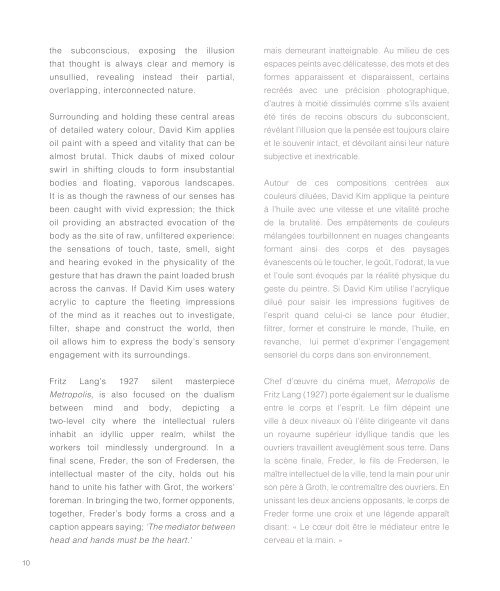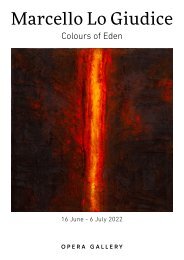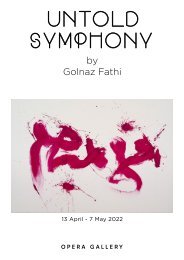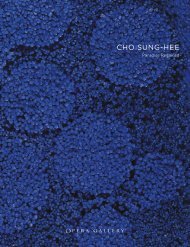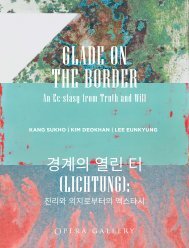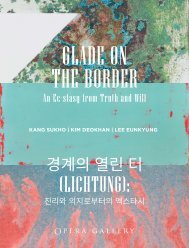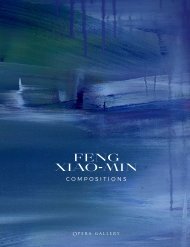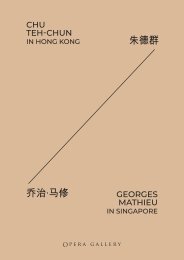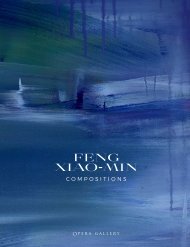David Kim Whittaker 'The Flesh to The Frame'
You also want an ePaper? Increase the reach of your titles
YUMPU automatically turns print PDFs into web optimized ePapers that Google loves.
the subconscious, exposing the illusion<br />
that thought is always clear and memory is<br />
unsullied, revealing instead their partial,<br />
overlapping, interconnected nature.<br />
Surrounding and holding these central areas<br />
of detailed watery colour, <strong>David</strong> <strong>Kim</strong> applies<br />
oil paint with a speed and vitality that can be<br />
almost brutal. Thick daubs of mixed colour<br />
swirl in shifting clouds <strong>to</strong> form insubstantial<br />
bodies and floating, vaporous landscapes.<br />
It is as though the rawness of our senses has<br />
been caught with vivid expression; the thick<br />
oil providing an abstracted evocation of the<br />
body as the site of raw, unfiltered experience:<br />
the sensations of <strong>to</strong>uch, taste, smell, sight<br />
and hearing evoked in the physicality of the<br />
gesture that has drawn the paint loaded brush<br />
across the canvas. If <strong>David</strong> <strong>Kim</strong> uses watery<br />
acrylic <strong>to</strong> capture the fleeting impressions<br />
of the mind as it reaches out <strong>to</strong> investigate,<br />
filter, shape and construct the world, then<br />
oil allows him <strong>to</strong> express the body’s sensory<br />
engagement with its surroundings.<br />
mais demeurant inatteignable. Au milieu de ces<br />
espaces peints avec délicatesse, des mots et des<br />
formes apparaissent et disparaissent, certains<br />
recréés avec une précision pho<strong>to</strong>graphique,<br />
d’autres à moitié dissimulés comme s’ils avaient<br />
été tirés de recoins obscurs du subconscient,<br />
révélant l’illusion que la pensée est <strong>to</strong>ujours claire<br />
et le souvenir intact, et dévoilant ainsi leur nature<br />
subjective et inextricable.<br />
Au<strong>to</strong>ur de ces compositions centrées aux<br />
couleurs diluées, <strong>David</strong> <strong>Kim</strong> applique la peinture<br />
à l’huile avec une vitesse et une vitalité proche<br />
de la brutalité. Des empâtements de couleurs<br />
mélangées <strong>to</strong>urbillonnent en nuages changeants<br />
formant ainsi des corps et des paysages<br />
évanescents où le <strong>to</strong>ucher, le goût, l’odorat, la vue<br />
et l’ouïe sont évoqués par la réalité physique du<br />
geste du peintre. Si <strong>David</strong> <strong>Kim</strong> utilise l’acrylique<br />
dilué pour saisir les impressions fugitives de<br />
l’esprit quand celui-ci se lance pour étudier,<br />
filtrer, former et construire le monde, l’huile, en<br />
revanche, lui permet d’exprimer l’engagement<br />
sensoriel du corps dans son environnement.<br />
Fritz Lang’s 1927 silent masterpiece<br />
Metropolis, is also focused on the dualism<br />
between mind and body, depicting a<br />
two-level city where the intellectual rulers<br />
inhabit an idyllic upper realm, whilst the<br />
workers <strong>to</strong>il mindlessly underground. In a<br />
final scene, Freder, the son of Fredersen, the<br />
intellectual master of the city, holds out his<br />
hand <strong>to</strong> unite his father with Grot, the workers’<br />
foreman. In bringing the two, former opponents,<br />
<strong>to</strong>gether, Freder’s body forms a cross and a<br />
caption appears saying; <strong>'<strong>The</strong></strong> media<strong>to</strong>r between<br />
head and hands must be the heart.'<br />
Chef d’œuvre du cinéma muet, Metropolis de<br />
Fritz Lang (1927) porte également sur le dualisme<br />
entre le corps et l’esprit. Le film dépeint une<br />
ville à deux niveaux où l’élite dirigeante vit dans<br />
un royaume supérieur idyllique tandis que les<br />
ouvriers travaillent aveuglément sous terre. Dans<br />
la scène finale, Freder, le fils de Fredersen, le<br />
maître intellectuel de la ville, tend la main pour unir<br />
son père à Groth, le contremaître des ouvriers. En<br />
unissant les deux anciens opposants, le corps de<br />
Freder forme une croix et une légende apparaît<br />
disant: « Le cœur doit être le médiateur entre le<br />
cerveau et la main. »<br />
10


